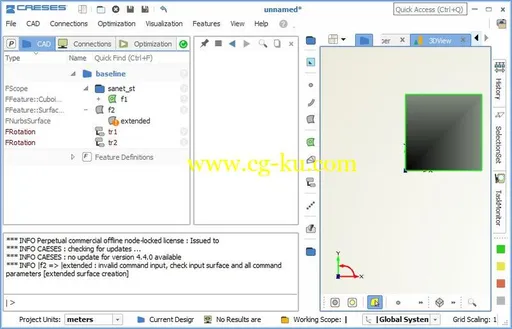CAESES是一款主要应用于产品设计前期的全参数化建模及优化软件,具有三维参数化建模及变形控制、耦合仿真软件进行性能评估、自动化优化等功能;目前被广泛应用于船舶、航空航天、汽车、叶轮机械等各个领域各类产品的设计及性能优化工作中。
主要功能及优势参数化建模CAESES拥有丰富的曲线及曲面库,能够通过函数曲线控制参数分布,进而生成参数化的曲面模型;基于其便捷的函数控制方法及模块化的建模程序,能够通过更少的参数构建更复杂的曲面模型,从而在之后的优化过程中,有效的减少设计变量数,降低优化变种数,大大提高优化效率。
另外CAESES还可以通过控制面、控制框等方式控制外部导入模型,进行半参数化的模型变化控制。
仿真分析工具链接CAESES的软件耦合器,能够方便的将网格生成器(ICEM、Turbogrid、IGG、Pointwise等)、CAE求解器(Fluent、Star-ccm+、Numeca、Ansys CFX、shipflow等)以及其它一些分析工具快速、直接地耦合在一起,可以灵活的定义仿真分析流程,并且能够提取仿真结果,从而判断模型性能优劣。
由于CAESES中几何模型是由自身创建,从而能够直接反馈调整几何模型,减少中间环节,保证了数据在模型—求解器—优化闭合回路中的通畅流动。
丰富的优化算法CAESES拥有多种不同的试验设计及单目标、多目标优化算法,能够根据仿真计算评估的结果,反馈控制几何参数变化,从而生成不同的新的设计变种,对模型进行自动化优化。
CAESES的后处理模块可以加载仿真结果文件,可以快速浏览不同设计变种的计算结果。
还可以自动生成一系列的数据列表,就各变量对目标函数的影响进行敏感度分析,自动生成包括蛛网图、Pareto frontier图在内的文件报告。
可实现的收益● 解决产品性能提升的迫切需求,在更短的时间内得出性能更优越的产品● 快速研究大量参数的相互影响,积累设计经验● 积累大量产品模型及分析结果数据库● 结合仿真工具建立产品设计、分析、优化平台,大幅提升工程师工作效率File size: 259/299 MBAre you using CFD (Computational Fluid Dynamics) to design flow-exposed products or components? Is the fluid dynamic behavior of your design critical for realizing the performance requirements? Are you doing a lot of manual iterative work, and hoping to find an incrementally better design? Would you like to boost your product development workflow by introducing an automated process that not only saves you time but also allows you to investigate tens or hundreds of design possibilities, resulting in superior products? If your answer is yes, then FRIENDSHIP-Framework could be the perfect solution for you.
FRIENDSHIP-Framework is a generalized CAE platform for the simulation-driven design of any products with flow-related tasks.
Our software allows you to automate your design variation studies and shape optimizations.
We integrate with most of the leading commercial CFD codes as well as in-house codes.
Parametric ModelingFRIENDSHIP-Framework’s foundation is a powerful and flexible 3D parametric modeler.
From the start, our modeling capabilities were specifically developed for simulation, especially CFD.
Unlike traditional CAD tools, FRIENDSHIP-Framework’s main focus is the smart design of complex flow-exposed functional surfaces.
For example, ship hulls, aircraft wings, arbitrarily shaped ducts, and turbomachinery blades are complex 3D shapes that are critical for achieving good performance in terms of the fluids flowing around or through them.
Our innovative and proprietary modeling architecture allows you to create these geometries using intuitive parameters that are of direct relevance with regards to your design practices.
With traditional CAD, your main design parameters include primary dimensions such as lengths, angles, and offsets.
In FRIENDSHIP-Framework you can additionally specify smart parameters and distributions of these parameters such as curvature, cross-sectional area, volumetric displacement, center of buoyancy, etc.
Many of our customers use FFW as their primary CAD tool, whereas others use it in a collaborative and integrated way with their traditional design and production CAD tools (e.
g.
CATIA, NX, Pro/E, SolidWorks).
These traditional tools, although powerful, are detail-oriented and encompass features which may not be relevant for simulation.
Naturally the extensive features of traditional tools means that they are not perfectly suited for specialized tasks such as driving a CFD-centric product development process.
Furthermore, specialized CAD designers are often the bottleneck to the CFD specialists, who rely on them for supplying the CAD model which they use as a basis for simulation.
Instead, the CFD engineers can use FRIENDSHIP-Framework to build specialized and flexible models that perfectly suite their exact needs.
When the optimized model is finalized, then FRIENDSHIP-Framework can pass the geometric data to the traditional CAD tool in order to continue the PLM process.
CFD CouplingFRIENDSHIP-Framework is also an integration platform that can launch and control the CFD simulation studies.
Any CFD code that can be run in batch mode from a geometry file and input script can be coupled to our software.
Many of our customers are using FRIENDSHIP-Framework in conjunction with popular commercial codes or proprietary in-house codes (e.
g.
STAR-CCM+, ANSYS Fluent/CFX, NUMECA products, OpenFOAM, SHIPFLOW to name a few).
Although our main focus is with regards to CFD simulations, other CAE tools can also be coupled.
Our optional SSH resource manager is a web interface that allows you to configure your PC resources on a network or cluster, so that you can utilize high-performance computing (HPC) for your CFD simulations.
Automated Variant Generation and OptimizationFRIENDSHIP-Framework’s parametric models are ideally suited for the automatic generation of design variants.
Once the models are set up with smart parameters or functions of parameters, then they can be varied in a number of different ways.
For example, you can configure a design engine to automatically vary the parameters within the set bounds in a user-specified manner.
The engine will systematically investigate the design space by linking to CFD (discussed below) to carry out the simulation studies.
FRIENDSHIP-Framework contains many sophisticated optimization algorithms ranging from single-objective strategies for fast and efficient studies, to more complex multi-objective techniques which are effective at conducting a global search of a highly non-linear design space containing many local minima and maxima.
These optimization algorithms provide feedback and drive the variation engines in order to find the best design as quickly as possible.
Variant Assessment and Post-ProcessingFRIENDSHIP-Framework includes its own post-processing environment.
You can easily step through the different design variants to compare the CFD results, sort them based on various objectives, investigate the influence of specific design parameters, and compare the most promising variants side by side.
It is possible to look at overall performance characteristics (e.
g.
resistance, pressure loss, lift coefficient, flow rates) or at the details of the flow patterns (e.
g.
cut plots, surface plots, trajectories).
You can further investigate your design space by viewing Pareto frontier plots and spider-web plots in order to understand the tradeoffs of changing the various design parameters on your performance objectives.
Finally, with FRIENDSHIP-Framework you can automatically create PDF or CSV reports of your design study.
CAESES_4.4.2.rar:CAESES_4.4.2.x64.rar:
